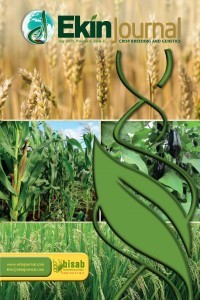Meteroglyph Analysis of Cowpea (Vigna unguiculata L.Walp) Elite Genotypes
Meteroglyph Analysis of Cowpea (Vigna unguiculata L.Walp) Elite Genotypes
Cowpea, meteroglyph analysis, odder yield, grain yield,
___
- Anderson E., (1957). A semi-graphical method for the analysis of complex problems. Proc. Natl. Acad. Sci. USA 43: 923-927.
- Bhandari M. S. and Verma J. S., (2007). Genetic divergence and correlation studies in forage cowpea [Vigna unguiculata (L.) Walp.]. Forage Res., 33: 133-138.
- Jain P., Saini M. L. and Arora R. N., (2006). Genetic divergence in cowpea. Forage Res.32: 12-14.
- Kumar M., (2015). Detection of genetic variation in crop plants. J. Biomol. Res. Ther. 4 : e140. doi: 10.4172/2167-7956.1000e140.
- Kumar S., D. Phogat, and N. Bhusal., (2015). Characterization of elite forage cowpea genotypes for various DUS traits. Forage Fes., 40 : 232-236.
- Lal T. and Vashisht V. K., (2008). Cowpea. In: Scientific Cultivation of Vegetables (Eds. Rana, M. K.). Kalyani publishers, New Delhi, pp. 25-47.
- Nagalakshmi R. M., R. Usha Kumari, and M. B. Boranayaka., (2010). Assessment of genetic diversity in cowpea (Vigna unguiculata). Electronic J. Pl. Breed. 1 : 453-461.
- Ng N. Q. and Maréchal R., (1985). Cowpea taxonomy, origin and germplasm. In: Cowpea Research, Production and Utilization (Eds Singh, S.R. and Rachie, K.O.). John Wiley and Sons, Ltd., Chichester, NY, pp. 11–21.
- Rana M. K., (2011). Classification of Vegetables. In: Fundamentals of Vegetable Production (Eds. Rana M. K.). New India Publishing Agency, New Delhi, pp Sanjeev B. G., M. R. Krishnappa, B. G. Shekara, and P. Rudraswamy., (2015). Gene action and combining ability for fodder yield and its contributing traits in fodder cowpea [Vigna unguiculata (L.) R. Br.] Forage Fes., 40 : 232-236.
- Singh B. B., Chambliss O. L., and Sharma, B., (1997). Recent advances in cowpea breeding. In: Advances in Cowpea Research (Eds. Singh, B.B., MohanRaj, D.R., Dashiell K.E. and Jackai L.E.N.), IITA-JIRCAS, Ibadan, pp. 30–49.
- Singh S. B., A. K. Singh, and A. P. Singh., (2010). Genetic variability, trait relationship and path analysis for green fodder yield and its components in cowpea (Vigna unguiculata) under rainfed environment. Progr. Agric., 10 : 42-46.
- Vu Nguyen Nagoc, R. K. Arya, R. Panchta and S. K. Pahuja, (2016). Studies on meteroglyph analysis in cowpea [Vigna unguiculata (L.) Walp] Forage Res., 41 (4) : 255-258. http:// forageresearch.in
- Vu Nguyen Ngoc, R. K. Arya, R. Panchta and Jayanti Tokas, (2017). Studies on genetic divergence in cowpea (Vigna unguiculata) by using D2 Statistics under semi-arid conditions. Forage Res., 43 (3) : 197-201.
- ISSN: 2149-1275
- Yayın Aralığı: Yılda 2 Sayı
- Başlangıç: 2015
- Yayıncı: Bitki Islahçıları Alt Birliği
Meteroglyph Analysis of Cowpea (Vigna unguiculata L.Walp) Elite Genotypes
Rajesh Kumar ARYA, Ravish PANCHTA, Nguyen Nagoc VU, Surender Kumar PAHUJA
Tea (Camellia sinensis) Cultivation and Breeding in Turkey: Past and Present Status
Fatih SEYIS, Emine YURTERI, Aysel OZCAN
Sudhir Kumar SETHI, Krishnendu GUIN, Rajesh Kumar ARYA
Recent Developments in Triticale Breeding Research and Production - An Overview
Performance of Wheat Genotypes for Grain Yield and its Attributes under Irrigation with Saline Water
Rishi Kumar BEHL, Babita KHOSLA, Pravin Kumar SHARMA, Mohammad AHATSHAM, Vikash VIKASH, Pratima PRATIMA, Vijay DAHIYA, Om Prakash BISHNOI
Halit KARAGOZ, Umran KUCUKOZDEMIR, Berrin DUMLU, Zeki YALCIN
